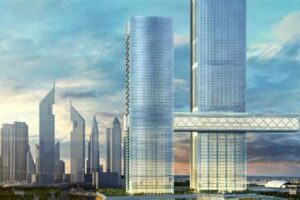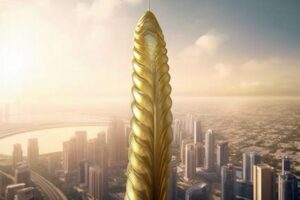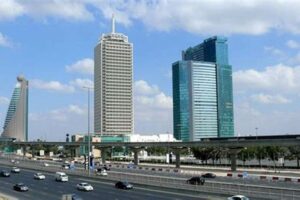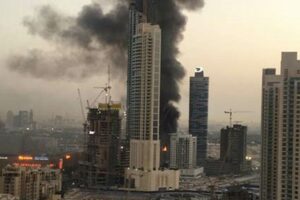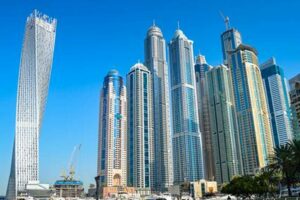Dubai skyscrapers are some of the tallest and most iconic buildings in the world, famous for their luxurious amenities, innovative designs, and record-breaking heights.
These architectural marvels have not only reshaped the skyline of Dubai but have also contributed significantly to its economic growth and global recognition. Many of these skyscrapers house world-class hotels, high-end residential units, state-of-the-art offices, and exclusive shopping malls, attracting tourists, investors, and businesses alike.
The construction of these skyscrapers has played a pivotal role in positioning Dubai as a prominent hub for tourism, finance, and international trade. They have also showcased the emirate’s commitment to innovation, engineering excellence, and sustainable development practices. As Dubai continues to grow and evolve, its skyscrapers will undoubtedly remain a defining characteristic of the city’s identity and a testament to its ambitious spirit.
1. Height
The height of Dubai skyscrapers, exemplified by the Burj Khalifa, is a defining characteristic that has shaped the city’s identity and global recognition. The construction of these towering structures has pushed the boundaries of architectural engineering and design, showcasing Dubai’s commitment to innovation and excellence.
The Burj Khalifa, standing at an astonishing 828 meters, is not just the world’s tallest building but also an iconic landmark that has become synonymous with Dubai. Its height has made it a global tourist destination, attracting visitors from around the world who marvel at its architectural grandeur and the breathtaking views it offers from its observation decks.
Moreover, the height of Dubai skyscrapers has practical significance. It allows for the creation of vertical communities within these buildings, offering residential, commercial, and hospitality spaces all under one roof. This mixed-use approach promotes sustainability by reducing urban sprawl and optimizing land use.
In conclusion, the height of Dubai skyscrapers, epitomized by the Burj Khalifa, is a key aspect that contributes to the city’s architectural prowess, global recognition, and sustainable urban development.
2. Design
The distinctive and innovative designs of Dubai skyscrapers have played a pivotal role in transforming them into architectural marvels that captivate the world. These designs go beyond mere aesthetics, showcasing engineering ingenuity and pushing the boundaries of construction.
- Iconic Landmarks: Skyscrapers like the Burj Al Arab, with its sail-shaped silhouette, have become iconic landmarks that symbolize Dubai’s architectural prowess and global recognition.
- Vertical Communities: Innovative designs allow for the creation of vertical communities within skyscrapers, integrating residential, commercial, and hospitality spaces, fostering a sense of community and convenience.
- Sustainable Architecture: Many skyscrapers incorporate sustainable design principles, utilizing energy-efficient materials, optimizing natural light, and implementing water conservation measures.
- Cultural Expression: The designs of Dubai skyscrapers often reflect cultural influences, incorporating traditional motifs and patterns, creating a unique blend of modernity and heritage.
In conclusion, the unique and innovative designs of Dubai skyscrapers are not just aesthetic marvels but also testaments to engineering brilliance, sustainability, and cultural expression, contributing to the city’s global architectural significance.
3. Luxury
The luxurious amenities found in Dubai skyscrapers, such as high-end residential units and world-class hotels, are an integral part of their appeal and contribute to the city’s reputation as an exclusive and desirable destination.
- Residential Units: Skyscrapers in Dubai offer a range of luxurious residential units, from spacious apartments to opulent penthouses, catering to the needs of discerning buyers who seek a sophisticated and comfortable lifestyle.
- Hotels: Dubai’s skyscrapers are home to some of the world’s most renowned and exclusive hotels, known for their impeccable service, lavish accommodations, and exceptional dining experiences, attracting both business travelers and leisure tourists.
- Amenities: These skyscrapers offer a wide array of amenities designed to enhance the lives of their residents and guests, including fitness centers, swimming pools, spas, and retail outlets, creating a self-contained and indulgent living environment.
- Global Recognition: The presence of luxurious amenities in Dubai skyscrapers has contributed to the city’s global recognition as a destination for luxury and opulence, attracting visitors and investors from around the world.
In conclusion, the luxury amenities offered by Dubai skyscrapers are a key factor in their appeal and global recognition, catering to the demands of a discerning clientele and reinforcing the city’s reputation as an exclusive and desirable destination.
4. Engineering
The advanced engineering techniques employed in the construction of Dubai skyscrapers have played a pivotal role in shaping the city’s skyline and architectural identity. These techniques have enabled the creation of towering structures that defy the limitations of conventional engineering and push the boundaries of architectural design.
One of the key engineering advancements that has made Dubai skyscrapers possible is the use of high-strength materials, such as reinforced concrete and steel alloys. These materials allow buildings to withstand the immense weight and wind forces associated with great heights. Additionally, innovative structural systems, such as diagrid frameworks and buttressed cores, have been developed to distribute loads more efficiently, reducing the need for bulky support structures.
Another crucial engineering aspect is the implementation of advanced construction methods. Techniques like slip-forming, which involves continuously pouring concrete into a mold that is raised as the structure grows, have enabled the rapid and efficient construction of skyscrapers. Moreover, the use of prefabricated building components has streamlined the construction process, ensuring accuracy and reducing on-site labor requirements.
The engineering ingenuity behind Dubai skyscrapers is not just about achieving height but also about creating functional and sustainable structures. Many skyscrapers incorporate energy-efficient building systems, such as double-glazed facades and solar panels, to reduce their environmental impact. Additionally, advanced fire safety systems and evacuation plans ensure the safety of occupants in the event of an emergency.
In conclusion, the advanced engineering techniques employed in the construction of Dubai skyscrapers have been instrumental in creating architectural marvels that redefine the possibilities of modern construction. By pushing the boundaries of engineering and design, Dubai has established itself as a global leader in innovative and sustainable skyscraper development.
5. Tourism
The connection between tourism and Dubai skyscrapers is undeniable, as these architectural wonders have emerged as major tourist attractions, drawing visitors from around the world. The Burj Khalifa, the world’s tallest building, is a prime example of how skyscrapers have become iconic landmarks that attract tourists seeking unique and memorable experiences.
The allure of Dubai skyscrapers lies in their architectural grandeur, innovative designs, and world-class amenities. Visitors are captivated by the opportunity to ascend to observation decks, such as the At the Top experience in the Burj Khalifa, offering breathtaking panoramic views of the city and beyond. Additionally, many skyscrapers house luxury hotels, upscale restaurants, and shopping malls, providing a complete and indulgent tourist experience.
The significance of tourism as a component of Dubai skyscrapers cannot be overstated. The revenue generated from tourism contributes to the city’s economy, supporting businesses and creating employment opportunities. Furthermore, tourism helps promote Dubai as a global destination, enhancing its reputation as a hub for luxury, innovation, and architectural excellence.
Understanding the connection between tourism and Dubai skyscrapers is crucial for urban planners, architects, and tourism industry professionals. By catering to the needs of tourists, such as providing accessible transportation, cultural experiences, and multilingual services, cities can maximize the benefits of skyscraper tourism while ensuring a positive and memorable experience for visitors.
6. Investment
The connection between investment and Dubai skyscrapers is a mutually beneficial relationship that has played a pivotal role in shaping the city’s economic landscape. Skyscrapers have acted as magnets for both domestic and international investments, leading to substantial economic growth and diversification.
One of the key factors driving investment in Dubai skyscrapers is their potential for high returns. The real estate market in Dubai is renowned for its strong performance, with skyscrapers offering attractive investment opportunities for individuals and institutions seeking lucrative returns on their capital. The Burj Khalifa, for example, has generated significant revenue from the sale of its residential and commercial units, contributing to its overall profitability.
Moreover, the presence of skyscrapers in Dubai has spurred the growth of various ancillary industries, creating a multiplier effect on the economy. The construction, maintenance, and operation of these towering structures have created numerous job opportunities, supported local businesses, and stimulated economic activity across various sectors.
Understanding the connection between investment and Dubai skyscrapers is crucial for investors, developers, and policymakers. By recognizing the economic benefits associated with skyscraper development, stakeholders can make informed decisions that contribute to the continued growth and prosperity of Dubai.
7. Sustainability
The pursuit of sustainability is deeply intertwined with the development of Dubai skyscrapers, as architects and engineers strive to minimize the environmental impact of these towering structures while promoting energy efficiency and occupant well-being.
- Energy-Efficient Designs: Skyscrapers in Dubai employ various energy-saving measures, such as double-glazed facades to reduce heat gain, LED lighting systems to minimize energy consumption, and smart building management systems to optimize energy usage. The Burj Khalifa, for example, utilizes a cladding system that reflects sunlight, reducing the need for air conditioning and lowering energy consumption.
- Water Conservation: With water scarcity being a concern in the region, Dubai skyscrapers incorporate water-saving fixtures and appliances. Advanced irrigation systems and rainwater harvesting techniques are also implemented to reduce water usage in landscaping and other non-potable applications.
- Green Building Materials: Sustainable materials are used in the construction of Dubai skyscrapers, including recycled steel, low-VOC paints, and sustainably sourced wood. These materials minimize the environmental impact associated with material extraction, production, and disposal.
- Indoor Environmental Quality: Skyscrapers in Dubai prioritize occupant well-being by providing ample natural light, fresh air ventilation, and thermal comfort. Green walls and indoor plants are incorporated to improve air quality and create a healthier indoor environment.
By embracing sustainability, Dubai skyscrapers are not only reducing their environmental footprint but also enhancing the quality of life for occupants and contributing to the city’s overall sustainability goals. These green building practices serve as a model for sustainable urban development in the region and beyond.
8. Global Recognition
Dubai’s skyscrapers have become globally renowned architectural marvels, propelling the city to the forefront of the international design stage. This recognition is a testament to the city’s commitment to innovation, architectural excellence, and its ambition to create iconic structures that redefine the boundaries of engineering and design.
- Architectural Innovation: Dubai’s skyscrapers push the limits of architectural design, showcasing innovative forms, futuristic facades, and cutting-edge construction techniques. The Burj Khalifa, for example, stands as a testament to the city’s architectural prowess, being the tallest building in the world and an emblem of modern engineering.
- Engineering Excellence: The construction of Dubai’s skyscrapers requires unparalleled engineering expertise, as these structures must withstand extreme weather conditions, seismic activity, and stringent safety regulations. Engineers have developed innovative structural systems and wind-resistant designs to ensure the stability and resilience of these towering giants.
- Economic Significance: The development of Dubai’s skyscrapers has had a profound impact on the city’s economy. These iconic structures have attracted significant investments, created job opportunities, and stimulated various sectors, such as tourism, real estate, and financial services.
- Cultural Impact: Dubai’s skyscrapers have become cultural landmarks, symbolizing the city’s rapid growth, ambition, and cultural diversity. They have featured in countless publications, films, and media, showcasing Dubai’s architectural achievements to a global audience.
The global recognition of Dubai’s skyscrapers extends beyond their architectural merits, as they have become symbols of the city’s ambitions and its position as a global hub for business, tourism, and innovation. These iconic structures continue to inspire architects, engineers, and city planners worldwide, solidifying Dubai’s place as a leading force in the world of architecture and design.
9. Economic Hub
Dubai skyscrapers are not just architectural marvels; they are also economic powerhouses that contribute significantly to the city’s global business hub status. The presence of multinational corporations and financial institutions in these skyscrapers has transformed Dubai into a thriving center for commerce, trade, and investment.
- Global Business Destination: Skyscrapers in Dubai provide world-class office spaces for multinational corporations, attracting businesses from various industries worldwide. These companies benefit from Dubai’s strategic location, tax-friendly environment, and advanced infrastructure, making it an ideal base for regional and international operations.
- Financial Center: Dubai’s skyscrapers house numerous financial institutions, including banks, investment firms, and asset management companies. The city’s robust regulatory framework, skilled workforce, and connectivity to global markets have made it a preferred destination for financial institutions seeking to expand their presence in the Middle East and beyond.
- Employment Opportunities: The growth of businesses in Dubai skyscrapers has created a multitude of employment opportunities for professionals in various fields, including finance, consulting, technology, and more. This has contributed to the city’s diverse and highly skilled workforce.
- Economic Diversification: The presence of multinational corporations and financial institutions in Dubai skyscrapers has helped diversify the city’s economy, reducing its dependence on oil and gas revenues. This diversification has enhanced Dubai’s economic resilience and long-term growth prospects.
In conclusion, the connection between Dubai skyscrapers and the city’s status as a global economic hub is undeniable. These skyscrapers provide a physical and economic foundation for businesses to thrive, contributing to Dubai’s reputation as a leading center for commerce, finance, and innovation.
Frequently Asked Questions about Dubai Skyscrapers
This section addresses common queries and misconceptions regarding Dubai’s skyscrapers, providing informative answers to enhance your understanding of these architectural marvels.
Question 1: What is the tallest skyscraper in Dubai?
The Burj Khalifa is the tallest skyscraper in Dubai, standing at an impressive height of 828 meters.
Question 2: Are Dubai’s skyscrapers safe?
Yes, Dubai’s skyscrapers adhere to strict safety regulations and employ advanced engineering techniques to withstand extreme weather conditions, seismic activity, and fire hazards.
Question 3: Are Dubai’s skyscrapers sustainable?
Many skyscrapers in Dubai incorporate sustainable design features, such as energy-efficient lighting, water-saving fixtures, and green building materials, to reduce their environmental impact.
Question 4: Can tourists visit the tops of Dubai’s skyscrapers?
Yes, several skyscrapers in Dubai offer observation decks that provide breathtaking panoramic views of the city. The Burj Khalifa’s “At the Top” experience is particularly renowned.
Question 5: Are Dubai’s skyscrapers expensive to build?
The construction costs of Dubai’s skyscrapers vary depending on factors such as height, design complexity, and materials used. However, they generally require significant investments due to their scale and sophisticated engineering.
Question 6: What is the future of skyscrapers in Dubai?
Dubai continues to push the boundaries of skyscraper design and innovation, with plans for even taller and more technologically advanced structures in the future. These skyscrapers are expected to incorporate cutting-edge sustainability features and redefine the skyline of Dubai.
In summary, Dubai’s skyscrapers are not only architectural marvels but also symbols of the city’s ambition, innovation, and commitment to sustainable urban development. Their presence contributes significantly to Dubai’s global recognition and economic growth.
Proceed to the next article section for further insights into Dubai’s architectural landscape.
Dubai Skyscraper Tips
Dubai’s skyscrapers are architectural marvels that offer unique experiences and investment opportunities. Here are some tips to make the most of your engagement with these iconic structures:
Tip 1: Plan Your Visit:
Before visiting Dubai’s skyscrapers, research their observation decks, ticket prices, and operating hours to plan your itinerary effectively. Consider visiting during off-peak seasons or weekdays for a less crowded experience.Tip 2: Consider the Views:
Each skyscraper offers a unique perspective of Dubai’s skyline. The Burj Khalifa provides panoramic city views, while the Ain Dubai observation wheel offers stunning vistas of the surrounding islands and coastline. Choose the skyscraper that best aligns with your desired views.Tip 3: Explore the Amenities:
Many Dubai skyscrapers house luxury hotels, restaurants, and shopping malls. Take advantage of these amenities to enhance your visit. Enjoy a fine dining experience with breathtaking views or indulge in retail therapy at upscale boutiques.Tip 4: Invest Wisely:
Dubai’s skyscrapers offer attractive investment opportunities in residential and commercial real estate. Conduct thorough research, consult with experts, and carefully consider your financial goals before making an investment decision.Tip 5: Admire the Engineering Marvels:
Appreciate the architectural ingenuity and engineering prowess behind Dubai’s skyscrapers. Learn about their innovative designs, sustainable features, and the construction challenges overcome during their development.Tip 6: Capture the Moment:
Don’t forget to capture the beauty of Dubai’s skyscrapers through photography. Use wide-angle lenses to capture the grandeur of these structures and experiment with different angles and perspectives to create stunning images.Tip 7: Stay Informed:
Dubai’s skyline is constantly evolving, with new skyscrapers emerging regularly. Stay updated on the latest developments and architectural trends to fully appreciate the city’s ever-changing cityscape.Tip 8: Respect the Culture:
Dubai’s skyscrapers are symbols of the city’s cultural heritage and modern aspirations. Respect local customs and dress codes while visiting these landmarks to ensure a positive and respectful experience.
By following these tips, you can fully immerse yourself in the architectural wonders of Dubai’s skyscrapers, gaining a deeper appreciation for their significance and beauty.
Proceed to the article’s conclusion for a comprehensive summary and final thoughts.
Conclusion
In conclusion, Dubai skyscrapers are architectural marvels that have transformed the city’s skyline and global perception. Their exceptional height, innovative designs, luxurious amenities, and sustainable features have made them iconic landmarks and symbols of Dubai’s ambition and progress. The presence of skyscrapers has not only attracted tourists and investments but has also contributed significantly to the city’s economic growth and status as a global business hub.
The continuous development and innovation in Dubai’s skyscraper landscape present exciting possibilities for the future. As the city continues to push the boundaries of architectural design and engineering, we can expect even more awe-inspiring skyscrapers to emerge, reshaping the skyline and redefining the limits of human ingenuity. Dubai’s unwavering commitment to architectural excellence ensures that its skyscrapers will remain a source of pride and inspiration for generations to come.


